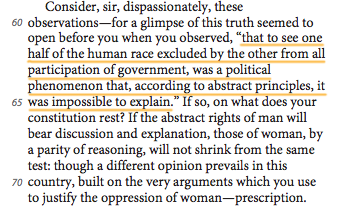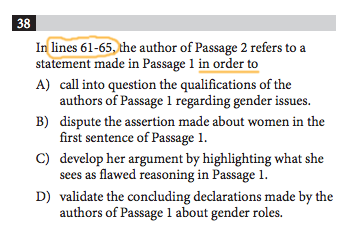
SAT Reading questions are notoriously tricky. They'll ask you to analyze passages in unfamiliar ways that seem confusing if you're not used to the format. It's helpful to have a basic game-plan for approaching tough Reading questions to make the Reading and Writing section less overwhelming. This article lays out a step-by-step process for interpreting Reading questions and lists a few tricks you should look out for to avoid making careless mistakes.
What’s in This Guide, and Who Should Read It?
This guide will provide you with a five-step process for breaking down and answering tricky Reading questions on the SAT. This is a list of all the steps you might consider taking to figure out Reading questions that stump you. I don’t advocate going through this entire process for every question (nor would it even be possible for many of them).
Although it's presented as a step-by-step process, it doubles as a list of tips that you can use in isolation depending on the question. The digital SAT Reading questions have pretty straightforward wording overall, but it’s still nice to have a strategy in mind before you dive into the test. At the end of this article, I’ll also tell you about some tricky question types you might encounter and how you can outsmart them.
If you’ve had some trouble on SAT Reading in the past (or know that reading just isn’t your strongest subject), the information in this article will probably benefit you.
 Alright, let's get nerdy.
Alright, let's get nerdy.
Step-By-Step: How to Correctly Interpret SAT Reading Questions
In this section, I’ll walk you through a step-by-step process for interpreting reading questions. Here’s the sample question (taken from one of the College Board's new SAT practice tests) that I'll use for demonstration:

I chose this question because it challenges you to consider statements made across two different passages. It also requires you to view the passage from the author’s perspective and develop some insight into his or her thought process.
Step 1: Read the Question Quickly and Note Line Numbers
First, do a quick read of the question to get a basic idea of what you’re facing. If there are line numbers in the question, circle them, and underline or bracket the corresponding lines in the passage:


Step 2: Underline Key Terms
After you read the question and mark the line numbers, start to pick it apart a little more so that you can zero in on its core meaning. Underline phrases that specify the type of answer you’re trying to find. Examples include:
Main Idea and detail question phrases like...
- Best summarizes
- Best describes
- Central idea
- Mainly serves to
- In order to
- Best evidence
- The author claims
- Would most likely agree
- Can be inferred
- Most clearly implies
You should also review all other parts of the question and underline any words or phrases that provide context (like paragraph and line numbers). In the sample question, I underlined the phrase “in order to” because it shows us the type of answer we want. The underlined phrase says that this question is asking specifically about the author’s goals in including the quote in the passage:

Some questions are too short or straightforward for this to be a useful tactic (there’s no point in underlining the whole question, after all). If the question is longer and asks you to consider a few different aspects of the reading, however, it's a helpful way to get your thoughts organized.
 Questions can seem like complex concept mazes, but if you underline key parts, you're less likely to miss the main point.
Questions can seem like complex concept mazes, but if you underline key parts, you're less likely to miss the main point.
Step 2.5: Rewrite the Question in Your Own Words
This step may be unnecessary, but if you find that the original wording of the question is confusing to you, it's sometimes helpful to rewrite it in a way that makes more sense. For the sample question we’re using, the original wording is:
In lines 61-65, the author of Passage 2 refers to a statement made in Passage 1 in order to
A rewrite might look something like this:
Why does the author of Passage 2 include the quote from Passage 1 in lines 61-65?
Or even just:
What is the purpose of the quote in lines 61-65?
Often, coming up with a simpler way to phrase the question can provide you with all the clarity you need to answer it accurately. This also works for questions that include less familiar vocabulary words or concepts that aren’t directly explained. If you rephrase it, you won't have to unravel this information all over again every time you reread the question.
Step 3: Predict the Answer Based on Evidence in the Passage
Now that you have a clearer idea of exactly what the question is asking, you can take a look back at the section of the passage that it references. You know you’re looking for WHY the quote is included, so you should review its surrounding context:

The essential question we’re considering is why the author of Passage 2 includes this quote from the author of Passage 1. In the context of the paragraph, it appears that the quote serves to point out a logical inconsistency in the argument advanced by the author of Passage 1.
The author of Passage 1 stated that “according to abstract principles, it was impossible to explain” the exclusion of women from politics. So, when it comes down to it, even the (misogynistic) author of Passage 1 can’t logically justify any disparity between the rights of men and women.
This is emphasized in the lines following the quote where the author of Passage 2 says “If so, on what does your constitution rest?” She points out that the author of Passage 1 has no logical grounds to claim that the rights of women should be given less consideration than those of men (“those of woman, by a parity of reasoning, will not shrink from the same test”).
 The author of Passage 2's response to the author of Passage 1.
The author of Passage 2's response to the author of Passage 1.
Step 4: Use Process of Elimination to Find Your Answer
You’ve read the question, you’ve figured out what it means, and you’ve even anticipated the answer! Now use process of elimination to decide which option fits best with your predictions:

Choice A can’t be right because the author isn’t using the quote to call the QUALIFICATIONS of the author of Passage 1 into question. She’s questioning his argument, but not necessarily his authority on the subject (although that definitely deserves to be questioned).
We can also discount Choice B because it's actually the opposite of what the author intends (the first sentence of Passage 1 is the quote cited in Passage 2). She expressly points out this statement as support for her argument.
Choice C is a likely answer based on our predictions in the previous step, so we’ll leave that one alone.
Choice D is another answer that is the polar opposite of what we want. Passage 1 argues that women should be excluded from politics, and Passage 2 argues that this point of view is illogical and immoral. Passage 2 is not attempting to validate any of the ultimate conclusions drawn by the author of Passage 1.
Step 5: Make Your Final Selection
It looks like Choice C is the clear winner. Before you commit and bubble in your answer, double check everything to make sure you didn't miss any key aspects of the question. This is a crucial step if you hope to eliminate careless mistakes!
3 Tricks to Watch Out For on SAT Reading
As a follow-up to the basic steps for interpreting reading questions, I'll list a few tactics the test might use to try and throw you off. Be on the lookout for these traps so you don't fall for them!
Apparent Subjectivity
You’ll see many of these types of phrases on the SAT Reading section:- “It can be inferred”
- “Most nearly means”
- “Would most likely agree”
This terminology implies that there will be a couple of answer choices that make sense, but one will make a little more sense than the others. NOPE. Reading questions are NOT subjective, and viewing them that way will only make the test harder. There is only one accurate answer for each question, and that answer is always supported by evidence in the passage. All the other choices are flat-out wrong. Don’t make things more difficult for yourself by assuming the SAT is more complex and nuanced than it is!
True Statement vs. Correct Answer
This point is related to the previous section’s discussion of the “only one correct answer” rule. As I said, there is only one accurate answer for each question, and you should be able to find evidence for that answer in the text.
However, there’s a big difference between a statement that’s technically accurate according to the passage and a statement that’s the correct answer to the specific question being asked. Sometimes, the SAT will include answer choices that are correct factually but don’t respond directly to the issue at hand. Take this question, for example:


Questions like this are why you need to read both the question and the relevant parts of the passage carefully before deciding on an answer. Just because an answer choice appears to be true at first glance doesn’t mean that it’s the appropriate response to the question.
 My car counts as a form of public transportation because I pick up ALLL the ladies awww yeahhh (*buys darker sunglasses to hide secret tears of loneliness*)
My car counts as a form of public transportation because I pick up ALLL the ladies awww yeahhh (*buys darker sunglasses to hide secret tears of loneliness*)
Deceptive Charts
The Reading section now includes data interpretation questions, which means that you’re gonna have to read some Crazy Charts and Goofy Graphs (I really want this to be the title of an actual SAT subscore category). If you don’t take the time to look closely at these charts and graphs and make sure you fully understand them, you'll run into some trouble. For example, I was confused by a question based on this pie chart:

 To me, both A and D seemed like correct answers, but that was because I hadn’t looked at the chart closely enough to grasp exactly what it was showing me. Choice D is incorrect because the graph doesn’t tell us anything about the FREQUENCY of use of public transportation in these different groups of people. It only tells us the makeup of the public transportation population in terms of numbers. Unemployed people could use public transportation just as often or more often as employed people. We don’t know based on the information we've been given.
To me, both A and D seemed like correct answers, but that was because I hadn’t looked at the chart closely enough to grasp exactly what it was showing me. Choice D is incorrect because the graph doesn’t tell us anything about the FREQUENCY of use of public transportation in these different groups of people. It only tells us the makeup of the public transportation population in terms of numbers. Unemployed people could use public transportation just as often or more often as employed people. We don’t know based on the information we've been given.
This example demonstrates that it’s critical to read closely and avoid making assumptions. Pie charts may seem like an easy-to-read, friendly type of chart, but sometimes the delicious apple-cinnamon filling is laced with a few drops of Sneaky SAT Serum™.
 Even pie can betray you. TRUST NO ONE.
Even pie can betray you. TRUST NO ONE.
Conclusion
SAT Reading questions and answers are sometimes confusingly worded. Although the new testing format aims to make them more accessible to students, it's still smart to plan out your strategy beforehand so you don't panic if you come across a tricky one. Here's a recap of the steps you should take to interpret SAT Reading questions accurately:
- Step 1: Read the Question Quickly and Note Line Numbers
- Step 2: Underline Key Terms
- Step 2.5: Rewrite the Question in Your Own Words
- Step 3: Predict the Answer Based on Evidence in the Passage
- Step 4: Use Process of Elimination to Find Your Answer
- Step 5: Make Your Final Selection
As you go through the steps, make sure you stay vigilant. The new SAT can still be tricky. Look out for:
- Questions that appear subjective (they're not!)
- Answers that are true but not correct responses to the question at hand
- Deceptive charts and graphs for data interpretation questions
If you keep practicing these skills with real SAT Reading questions, by the time you take the test you'll be able to handle any curveballs the College Board throws your way.
What's Next?
The new SAT may be easier or harder for you depending on your academic strengths. Learn about ways the new SAT could be more challenging or less challenging for certain students.
What's a good score on the new SAT? Find out what score you should be aiming for on the new scale out of 1600 based on your goals.
The SAT isn't the best standardized testing option for everyone. Check out this article for advice on whether you should take the new SAT or the ACT.











